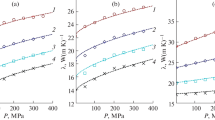Abstract
Electromigration of molten tin-based inclusions in single-crystal p-GaSb:Zn(111) was studied. It was shown that molten inclusions are displaced by a current (j=(1–4)×105 A/m2) toward a negative electrode in the temperature range T=750–920 K. The mechanism of this phenomenon was shown to be related to concentration changes in the bulk of molten inclusions. It was noted that the inclusion transport is initiated by two competing processes: the temperature changes at phase interfaces caused by the Peltier heat and the electric transport, leading to the redistribution of components, depending on their effective charges in the melt. The size dependence of the velocity of inclusion motion W in the bulk of a single-crystal matrix was determined: W increases with the inclusion size. The numerical values of the thermoelectric parameters of all the contacting phases were experimentally determined using independent methods. This made it possible, fitting the theory to the experimental data, not only to estimate quantitatively the effective charge Z* of a molten semiconductor, but also to explain the size dependence of the activation barrier overcome by a drifting inclusion.
Similar content being viewed by others
References
Ya. E. Geguzin and M. A. Krivoglaz, Migration of Macroscopic Inclusions in Solids, 2nd ed. (Moscow, Nauka, 1985; Consultants Bureau, New York, 1973).
D. K. Belashchenko, Transport Phenomena in Liquid Metals and Semiconductors (Atomizdat, Moscow, 1970).
J. P. Dekker, C. A. Volkert, E. Arzt, and P. Gumbsch, Phys. Rev. Lett. 87, 35901 (2001).
A. Bonapasta, Phys. Rev. B 65, 045308 (2002).
Ho Mon-Shu, Hwang Ing-Shouh, and Tsong Tien, Phys. Rev. Lett. 84, 5792 (2000).
D. K. Belashchenko, A. M. Orlov, and V. I. Parkhomenko, Izv. Akad. Nauk SSSR, Neorg. Mater. 10, 1728 (1975).
A. M. Orlov, A. A. Skvortsov, and B. M. Kostishko, Teplofiz. Vys. Temp. 3, 404 (1997).
I. N. Larionov, N. M. Roizin, V. M. Nogin, and É. T. Avrasin, Fiz. Tverd. Tela (Leningrad) 9, 1414 (1967) [Sov. Phys. Solid State 9, 1103 (1967)].
A. M. Orlov, A. A. Skvortsov, and A. A. Salanov, Pis'ma Zh. Tekh. Fiz. 27(19), 76 (2001) [Tech. Phys. Lett. 27, 834 (2001)].
Physical Chemistry, Ed. by B. P. Nikol'skii (Khimiya, Moscow, 1987).
E. I. Eroshinkova, A. M. Zakharov, and V. G. Olenicheva, Phase Diagrams of Metal Systems Published in 1982–1983 (Metallurgiya, Moscow, 1985).
V. M. Glazov, S. N. Chizhevskaya, and N. N. Glagoleva, Liquid Semiconductors (Nauka, Moscow, 1967; Plenum, New York, 1969).
V. M. Glazov, M. Wobst, and V. I. Timoshenko, Methods of Investigation of the Properties of Liquid Metals and Semiconductors (Metallurgiya, Moscow, 1989).
R. R. Heikes, Ure Termoelectrodity (Interscience, New York, 1961).
Author information
Authors and Affiliations
Additional information
__________
Translated from Fizika i Tekhnika Poluprovodnikov, Vol. 38, No. 4, 2004, pp. 391–394.
Original Russian Text Copyright © 2004 by Orlov, Skvortsov, Salanov.
Rights and permissions
About this article
Cite this article
Orlov, A.M., Skvortsov, A.A. & Salanov, A.A. Electric transport in gallium antimonide single crystals involving molten GaSb-Sn inclusions. Semiconductors 38, 376–379 (2004). https://doi.org/10.1134/1.1734661
Received:
Accepted:
Issue Date:
DOI: https://doi.org/10.1134/1.1734661




